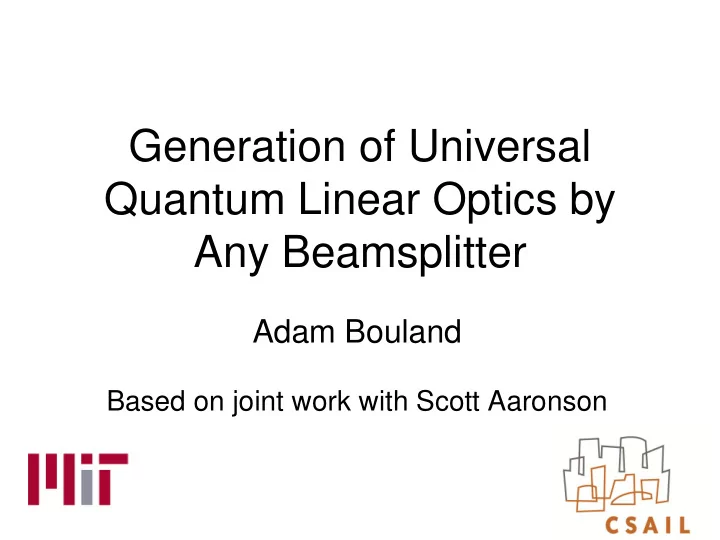

Generation of Universal Quantum Linear Optics by Any Beamsplitter Adam Bouland Based on joint work with Scott Aaronson
Two-level Unitaries
Two-level Unitaries Reck et al : By composing 2-level unitaries, can create any matrix in U(m) . . .
Two-level Unitaries What if you can’t perform any two-level unitary, but only those from some finite set S? (Assume you can apply any element in S as many times as you want, to whatever indices you want.)
Two-level Unitaries S= (Assume you can apply any element in S as many times as you want, to whatever indices you want.) . . .
Two-level Unitaries • Obviously don’t generate SU(m) • Not obvious:
Our results Q: Are there any interesting sets S which don’t generate SU(m), SO(m), or merely permutations for large m?
Our results • Thm : [B. Aaronson ’14] Any two level- unitary of determinant -1 with all non-zero entries densely generates SU(m) or SO(m) for m>=3. – Real -> generates SO(m) – Complex -> generates SU(m)
Our results Proof:
Quantum Optics 1 photon, m modes
Beamsplitter
Beamsplitter Beamsplitter = a two-level unitary of determinant -1. Our result: Any beamsplitter which mixes modes generates SO(m) and SU(m) on single photon with m>=3 modes
Quantum Optics n photons, m modes 200 011 110 101 020 002
Quantum Optics • Unitary on larger space “lifted” by homomorphism from single photon space. “The linear optical group”
Quantum Optics Despite not being able to perform all unitaries, optics are difficult to simulate classically: • Non-adaptive: BosonSampling • Adaptive: BQP (KLM protocol)
Quantum Optics • Def: A set of beamsplitters is universal for quantum optics on m modes if it densely generates SU(m) or SO(m) when acting on a single photon over m modes. Solovay-Kitaev: Any set of universal optical elements is computationally equivalent.
Our results Theorem [B. Aaronson ‘14] : Any beamsplitter which mixes modes is universal for quantum optics on 3 or more modes
Our results Theorem [B. Aaronson ‘14] : For any beamsplitter b, quantum optics with b is either efficiently classically simulable or else universal for quantum optics A priori: could get a model • Nontrivially simulable, like Clifford group • Still capable of universal optics via an encoding, like matchgates • Computationally intermediate
Our results Theorem [B. Aaronson ‘14] : For any beamsplitter b, quantum optics with b is either efficiently classically simulable or else universal for quantum optics Universal Samp-BPP Boson Sampling/ KLM
Our results Theorem [B. Aaronson ‘14] : For any beamsplitter b, quantum optics with b is either efficiently classically simulable or else universal for quantum optics
Proof Sketch
Proof Sketch Let G M =<R 1 ,R 2 ,R 3 > G M represents G < SU(3) Fact 1: G M is a 3-dimensional irreducible representation (irrep) of G Fact 2: G is closed We know all irreps of closed subgroups of SU(3)
Proof Sketch Closed Subgroups of SU(3) (1917/1963/ 2013 ): • Subgroups of SU(2) • 12 exceptional groups • Two sets of infinite families: • 2 disconnected Lie groups • 4 connected Lie groups
Proof Sketch Closed Subgroups of SU(3) (1917/1963/ 2013 ): • Subgroups of SU(2) • 12 exceptional groups • Two sets of infinite families: • 2 disconnected Lie groups • 4 connected Lie groups G=SU(3) or SO(3)
Proof Sketch
Proof Sketch
Proof Sketch
Proof Sketch
Proof Sketch
Conclusion • Thm : [B. Aaronson ’14] Any beamsplitter which mixes modes is universal on ≥3 modes .
Open questions • Can we extend to multi-mode beamsplitters? • Can we extend this to two-level unitaries with other determinants? • Can we account for realistic errors? • Is there a qubit version of this theorem?
Questions ?
Recommend
More recommend